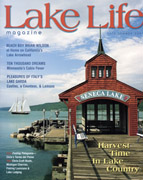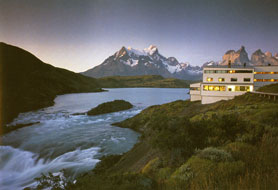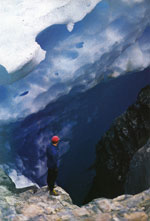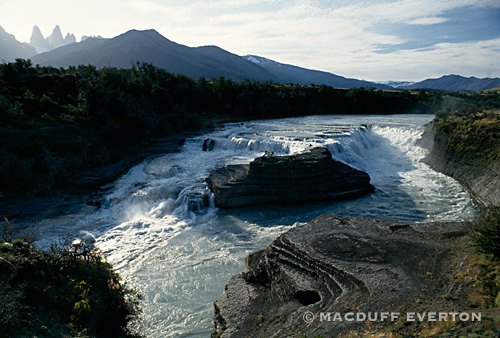| Artwork | Index | Editorial Writing | |
| Books | About | Links |
| Mary Heebner |
|
Lake Life by Mary Heebner |

|
|
|
|
You could travel
from Paris to Athens and back again and cover the same distance you
would following the warp-threads of the slender weave of a country called
Chile. Torres del Paine National Park, (in Chilean Patagonia) was declared
a Biosphere Reserve by UNESCO in 1978, and it remains one of the most
remote and unspoiled places on the planet. Some 20,000 years ago this
region was covered in ice. Yet today the Southern Patagonian Icefield
may be the fastest melting icefield on earth.
|
|
| At sunset, a wash of milky purple covers the Cuernos del Paine (above), a fortress of rock that appears to covet light while cradling cold. The last light of a summer’s evening lingers for over an hour. The Hotel Explora, designed by renowned Chilean architect German del Sol, melds into the surrounding heath of cool greens, interspersed with wildflowers, spindly steppe grasses, and stands or cohiue, lenga, and nirre trees. Walking along del Sol’s signature meandering boardwalk immerses you in the landscape and draws you to the water’s edge, as the pathways make it possible to tread softly through this fragile terrain. Below right: Ice is a filter — the thicker the ice, the bluer the color. As the incident light penetrates layers of ice, as at Grey Glacier, the rest of the spectral red and yellow hues fall away; only hues of blue and green make it through. |  |
|
Air currents from the Pacific Ocean confront the volcanic mountains. Clouds form in an instant, and wind flings them like Pollock’s loaded paintbrush. At Lago Pehoe , you can watch weather being born. During summer months (January through March), the mere six hours of darkness are a slight interruption in the day, yet a single day might contain all four seasons, with sudden snowstorms, radiant sunshine, rain, and wind. Guanacos descend from a camel-like ancestor that crossed a land bridge and later became extinct in North America. Skittish, the guanacos bolt like deer, whinny and snort like horses, have a camel’s long neck clothed in fine white fur, and sport a saddle of fur that drapes down just below their belly, like a serape. Other animals in the park include the ostrich-like rhea and the Patagonian fox. Glaciers seem to weep out of the earth. Over time, countless
layers of snow have resisted the sun to compact the ice so heavily
that the bottom layer slides; the downflow is called a glacier. Out
at the end of the spit of land, the blunt face of the glacier towers
above, staggering in its immensity. |
 |
|
 |
|
|
The
massive granite peaks of Cuernos del Paine rise from the diverse tundra
and steppe vegetation that blossomed after Patagonia’s last glaciation
14,000 years ago. This is one of the most rugged environments on earth,
yet viewed from a distance, Cuernos del Paine and Lago Pehoe seem curiously
benign. |
||
|
References: ©2005 Mary Heebner |
||